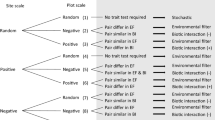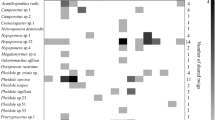Abstract
One of the fundamental questions in community ecology is whether communities are random or formed by deterministic mechanisms. Although many efforts have been made to verify non-randomness in community structure, little is known with regard to co-occurrence patterns in above-ground and below-ground communities. In this paper, we used a null model to test non-randomness in the structure of the above-ground and below-ground mite communities in farmland of the Sanjiang Plain, Northeast China. Then, we used four tests for non-randomness to recognize species pairs that would be demonstrated as significantly aggregated or segregated co-occurrences of the above-ground and below-ground mite communities. The co-occurrence pattern of the above-ground mite community was significantly non-random in October, suggesting species segregation and hence interspecific competition. Additionally, species co-occurrence patterns did not differ from randomness in the above-ground mite community in August or in below-ground mite communities in August and October. Only one significant species pair was detected in the above-ground mite community in August, while no significant species pairs were recognized in the above-ground mite community in October or in the below-ground mite communities in August and October. The results indicate that non-randomness and significant species pairs may not be the general rule in the above-ground and below-ground mite communities in farmland of the Sanjiang Plain at the fine scale.
Similar content being viewed by others
References
Adams D C, 2007. Organization of Plethodon salamander communities: Guild-based community assembly. Ecology, 88(5): 1292–1299. doi: 10.1890/06-0697
Albrecht M, Gotelli N J, 2001. Spatial and temporal niche partitioning in grassland ants. Oecologia, 126(1): 134–141. doi: 10.1007/s004420000494
Balogh J, Balogh P, 1992. The Oribatid Mites Genera of the World (Vol. 1 and 2). Budapest: The Hungarian National Museum Press, 263, 371.
Bardgett R D, Wardle D A, 2010. Aboveground-belowground Linkages: Biotic Interactions, Ecosystem Processes, and Global Change. Oxford: Oxford University Press, 1–287.
Benjamini Y, Yekutieli D, 2001. The control of the false discovery rate in multiple testing under dependency. The Annals of Statistics, 29(4): 1165–1188. doi: 10.2307/2674075
Caruso T, Taormina M, Migliorini M, 2012. Relative role of deterministic and stochastic determinants of soil animal community: A spatially explicit analysis of oribatid mites. Journal of Animal Ecology, 81(1): 214–221. doi: 10.1111/j.1365-2656.2011.01886.x
Caruso T, Trokhymets V, Bargagli R et al., 2013. Biotic interactions as a structuring force in soil communities: Evidence from the micro-arthropods of an Antarctic moss model system. Oecologia, 172(2): 495–503. doi: 10.1007/s00442-012-2503-9
Chave J, 2004. Neutral theory and community ecology. Ecology Letters, 7(3): 241–253. doi: 10.1111/j.1461-0248.2003.00566.x
Connor E F, Simberloff D, 1979. The assembly of species communities: Chance or competition? Ecology, 60(6): 1132–1140. doi: 10.1016/j.apsoil.2008.01.007
Decaëns T, Margerie P, Aubert M et al., 2008. Assembly rules within earthworm communities in north-western France—A regional analysis. Applied Soil Ecology, 39(3): 321–335. doi: 10.1016/j.apsoil.2008.01.007
Deyna G B D, Putten W H V, 2005. Linking aboveground and belowground diversity. Trends in Ecology & Evolution, 20(11): 625–633. doi: 10.1016/j.tree.2005.08.009
Diamond J M, 1975. Assembly of Species Communities. Cambridge: Harvard University Press, 342–444.
Ehouman N M, Tiho S, Dagnogo M, 2012. Co-occurrence of earthworms in Lamto savanna: A null model analysis of community structure. European Journal of Soil Biology, 53(11–12): 40–47. doi: 10.1016/j.ejsobi.2012.08.007
Ellwood M D F, Manica A, Foster W A, 2009. Stochastic and deterministic processes jointly structure tropical arthropod communities. Ecology Letters, 12(4): 277–284. doi: 10.1111/j.1461-0248.2009.01284.x
Escoriza D, Boix D, 2012. Assessing the potential impact of an invasive species on a Mediterranean amphibian assemblage: A morphological and ecological approach. Hydrobiologia, 680(1): 233–245. doi: 10.1007/s10750-011-0936-5
Ettema C H, Yeates G W, 2003. Nested spatial biodiversity patterns of nematode genera in a New Zealand forest and pasture soil. Soil Biology and Biochemistry, 35(2): 339–342. doi: 10.1016/S0038-0717(02)00276-6
Fayle T M, Manica A, 2010. Reducing over-reporting of deterministic co-occurrence patterns in biotic communities. Ecological Modelling, 221(19): 2237–2242. doi: 10.1016/j.ecolmodel.2010.06.013
Feeley K, 2003. Analysis of avian communities in Lake Guri, Venezuela, using multiple assembly rule models. Oecologia, 137(1): 104–113. doi: 10.1007/s00442-003-1321-5
Fiera C, Ulrich W, 2012. Spatial patterns in the distribution of European springtails (Hexapoda: Collembola). Biological Journal of the Linnean Society, 105(3): 498–506. doi: 10.1111/j.1095-8312.2011.01816.x
Fox B J, Brown J H, 1993. Assembly rules for functional groups in north American desert rodent communities. Oikos, 67(2): 358–370.
Gotelli N J, 2000. Null model analysis of species co-occurrence patterns. Ecology, 81(9): 2606–2621. doi: 10.1890/0012-9658(2000)081
Gotelli N J, 2002. Research frontiers in null model analysis. Global Ecology and Biogeography, 10(4): 337–343. doi: 10.1046/j.1466-822X.2001.00249.x
Gotelli N J, Ellison A M, 2002. Assembly rules for New England ant assemblages. Oikos, 99(3): 591–599. doi: 10.1034/j.1600-0706.2002.11734.x
Gotelli N J, Entsminger G L, 2009. Ecosim: Null models software for ecology (version 7). Acquired Intelligence Inc. and Kesey-Bear: Jericho, VT, USA. Available at: http:/garyentsminger.com/ecosim.htm.
Gotelli N J, Graves G R, 1996. Null Models in Ecology. Washington: Smithsonian Institution Press, 1–368.
Gotelli N J, McCabe D J, 2002. Species co-occurrence: A meta-analysis of J M Diamond’s assembly rules model. Ecology, 83(8): 2091–2096. doi: 10.1890/0012-9658(2002)083
Gotelli N J, Rohde K, 2002. Co-occurrence of ectoparasites of marine fishes: A null model analysis. Ecology Letters, 5(1): 86–94. doi: 10.1046/j.1461-0248.2002.00288.x
Gotelli N J, Ulrich W, 2010. The empirical Bayes approach as a tool to identify non-random species associations. Oecologia, 162(2): 463–477. doi: 10.1007/s00442-009-1474-y
Gotelli N J, Ulrich W, 2012. Statistical challenges in null model analysis. Oikos, 121(2): 171–180. doi: 10.1111/j.1600-0706.2011.20301.x
Graves G R, Gotelli N J, 1993. Assembly of avian mixed-species flocks in Amazonia. Proceedings of the National Academy of Sciences of the United States of America, 90(4): 1388–1391. doi: 10.1073/pnas.90.4.1388
Gutiérrez-López M, Jesús J B, Trigo D et al., 2010. Relationships among spatial distribution of soil microarthropods, earthworm species and soil properties. Pedobiologia, 53(6): 381–389. doi: 10.1016/j.pedobi.2010.07.003
Hanski I, 1982. Communities of bumblebees: Testing the core-satellite species hypothesis. Annales Zoologici Fennici, 19: 65–73.
Haukisalmi V, Henttonen H, 1998. Analysing interspecific associations in parasites: Alternative methods and effects of sampling heterogeneity. Oecologia, 116(4): 565–574. doi: 10.1007/s004420050622
Ingimarsdóttir M, Caruso T, Ripa J et al., 2012. Primary assembly of soil communities: Disentangling the effect of dispersal and local environment. Oecologia, 170(3): 745–754. doi: 10.1007/s00442-012-2334-8
Jiménez J J, Decaëns T, Rossi J P, 2012. Soil environmental heterogeneity allows spatial co-occurrence of competitor earthworm species in a gallery forest of the Colombian’ Llanos’. Oikos, 121(6): 915–926 doi: 10.1111/j.1600-0706.2012.20428.x
Jiménez J J, Rossi J P, 2006. Spatial dissociation between two endogeic earthworms in the Colombian ‘Llanos’. European Journal of Soil Biology, 42(S1): S218–S224 doi: 10.1016/j.ejsobi.2006.07.032
Jiménez J J, Rossi J P, Lavelle P, 2001. Spatial distribution of earthworms in acid-soil savannas of the eastern plains of Colombia. Applied Soil Ecology, 17(3): 267–278. doi: 10.1016/S0929-1393(01)00133-0
Krantz G W, 1978. A manual of Acarology. Corvallis: Oregon State University Book Stores Inc., 1–509.
Krantz G W, Walter D E, 2009. A Manual of Acarology (Third edition). Lubbock: Texas Tech University Press, 1–807.
Krasnov B R, Shenbrot G I, Khokhlova I S, 2011. Aggregative structure is the rule in communities of fleas: Null model analysis. Ecography, 34(5): 751–761. doi: 10.1111/j.1600-0587.2010.06597.x
Leibold M A, Mikkelson G M, 2002. Coherence, species turnover, and boundary clumping: Elements of meta-community structure. Oikos, 97(2): 237–250. doi: 10.1034/j.1600-0706.2002.970210.x
Lindo Z, Winchester N N, 2009. Spatial and environmental factors contributing to patterns in arboreal and terrestrial oribatid mite diversity across spatial scales. Oecologia, 160(4): 817–825. doi: 10.1007/s00442-009-1348-3
Patterson B D, Atmar W, 1986. Nested subsets and the structure of insular mammalian faunas and archipelagos. Biological Journal of the Linnean Society, 28(1–2): 65–82. doi: 10.1111/j.1095-8312.1986.tb01749.x
Pitta E, Giokas S, Sfenthourakis S, 2012. Significant pairwise co-occurrence patterns are not the rule in the majority of biotic communities. Diversity, 4(2): 179–193. doi: 10.3390/d4020179
Pitzalis M, Luiselli L, Bologna M A, 2010. Co-occurrence analyses show that non-random community structure is disrupted by fire in two groups of soil arthropods (Isopoda Oniscidea and Collembola). Acta Oecologica, 36(1): 100–106. doi: 10.1016/S0929-1393(01)00133-0
Rossi J P, Nuutinen V, 2004. The effect of sampling unit size on the perception of the spatial pattern of earthworm (Lumbricus terrestris L.) middens. Applied Soil Ecology, 27(2): 189–196. doi: 10.1016/j.apsoil.2004.03.001
Sanders N J, Gotelli N J, Wittman S E et al., 2007. Assembly rules of ground-foraging ant assemblages are contingent on disturbance, habitat and spatial scale. Journal of Biogeography, 34(9): 1632–1641. doi: 10.1111/j.1365-2699.2007.01714.x
Schluter D, 1984. A variance test for detecting species associations, with some example applications. Ecology, 65(3): 998–1005. doi: 10.2307/1938071
Sfenthourakis S, Tzanatos E, Giokas S et al., 2006. Species co-occurrence: The case of congeneric species and a causal approach to patterns of species association. Global Ecology and Biogeography, 15(1): 39–49. doi: 10.1111/j.1466-822X.2005.00192.x
Stone L, Roberts A, 1990. The checkerboard score and species distribution. Oecologia, 85(1): 74–79. doi: 10.1007/BF00317345
Ulrich W, 2004. Species co-occurrences and neutral models: Reassessing J M Diamond’s assembly rules. Oikos, 107(3): 603–609. doi: 10.1111/j.0030-1299.2004.12981.x
Ulrich W, 2008. Pairs-a FORTRAN program for studying pair-wise species associations in ecological matrices (Version 1.0). Available at: www.uni.torun.pl/~ulrichw.
Ulrich W, Gotelli N J, 2007. Disentangling community patterns of nestedness and species co-occurrence. Oikos, 116(12): 2053–2061. doi: 10.1111/j.2007.0030-1299.16173.x
Veech J A, 2006. A probability-based analysis of temporal and spatial co-occurrence in grassland birds. Journal of Biogeography, 33(12): 2145–2153. doi: 10.1111/j.1365-2699.2006.01571.x
Walter D E, Proctor H C, 2001. Mites in Soil (CD-ROM). Collingswood: CSIRO Publishing.
Ward D, Beggs J, 2007. Coexistence, habitat patterns and the assembly of ant communities in the Yasawa islands, Fiji. Acta Oecologica, 32(2): 215–223. doi: 10.1016/j.actao.2007.05.002
Wardle D A, Bardgett R D, Klironomos J N et al., 2004. Ecological linkages between aboveground and belowground biota. Science, 304(5677): 1629–1633. doi: 10.1126/science.1094875
Wilson J B, Whittaker R J, 1995. Assembly rules demonstrated in saltmarsh community. Journal of Ecology, 83(5): 801–807.
Yin Wenying, Hu Shenghao, Shen Yunfen et al., 1998. Pictorical Keys to Soil Animals of China. Beijing: Science Press, 527–562. (in Chinese)
Author information
Authors and Affiliations
Corresponding authors
Additional information
Foundation item: Under the auspices of National Natural Science Foundation of China (No. 41101049, 40601047, 41371072, 31101617, 41171047), China Postdoctoral Science Foundation (No. 2012M511361), Excellent Youth Scholars of Northeast Institute of Geography and Agroecology, Chinese Academy of Sciences (No. DLSYQ2012004), Fund for Distinguished Young Scholar of Harbin Normal University (No. KGB201204), Scientific Innovation Project for Doctoral Candidate of Harbin Normal University (No. HSDBSCX2012-07)
Rights and permissions
About this article
Cite this article
Lin, L., Gao, M., Liu, D. et al. Co-occurrence patterns of above-ground and below-ground mite communities in farmland of Sanjiang Plain, Northeast China. Chin. Geogr. Sci. 24, 339–347 (2014). https://doi.org/10.1007/s11769-014-0683-4
Received:
Accepted:
Published:
Issue Date:
DOI: https://doi.org/10.1007/s11769-014-0683-4




